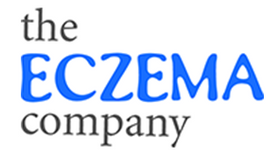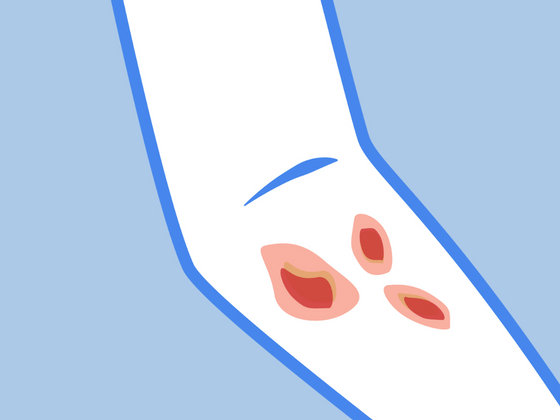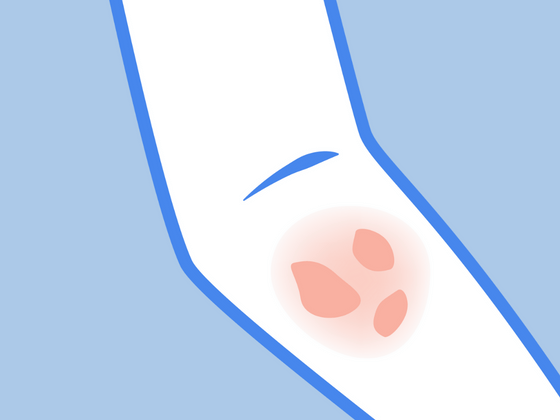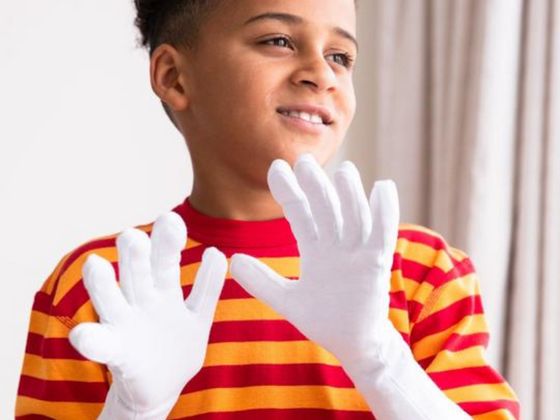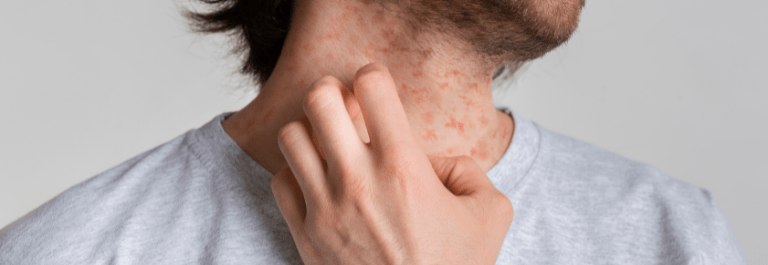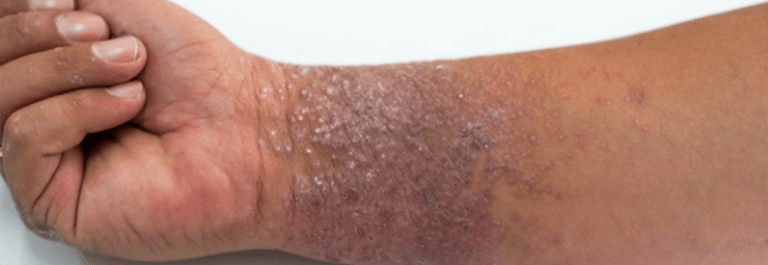Eczema is an umbrella term to describe a group of skin conditions that cause inflammation, dryness, irritation, and itchiness. Each type of eczema has different triggers and treatment options. A common condition, it affects around 10-20% of the world population. But how many types of eczema are there? Read on to find out.
Please keep in mind that although these tips and information have worked for several sufferers, we are in no way medical professionals. If you’re experiencing severe symptoms or have a topical infection, it is always best to seek medical advice immediately.
Atopic dermatitis
This is the most common type of eczema. It usually develops during childhood but can affect adults as well. Although atopic dermatitis can occur on its own, it usually exists along with other types of eczema on arms or other parts of the body. Itch is its prime characteristic but it’s also accompanied by skin redness, dryness, scaliness, cracked skin, and oozing skin.
To combat uncomfortable symptoms, treat your skin to this Baby & Adult Soother. It’s created using just three Chinese herbs in a base of olive oil and beeswax and is perfect for calming itchy eczema all over the body.
Contact dermatitis
Contact dermatitis occurs when the skin comes into contact with a substance or material that causes a reaction. For this reason, it’s one of the different types of eczema on hands for people who regularly touch chemicals, allergens, or irritants because of their job. This includes hairstylists, cooks, and healthcare workers. It can also affect people on an everyday basis as many irritants are found in common household items or beauty products. For example, many irritants are found in soaps, detergents, make up, skincare, and even the clothes you wear.
These cotton gloves for kids and adults were specifically made with skin health in mind. Made with 100% organic cotton, they’re a soothing and soft solution for cracked, dry, or itchy hands.
Neurodermatitis
This is one of the types of eczema on legs, arms, and back of the neck. Areas such as the genitals, shoulders, and scalp can also be affected. It causes the skin to appear thick and leathery, often as a result of the vicious itch-scratch cycle. Under stress or during an emotionally difficult time, symptoms of neurodermatitis may be heightened and itchiness can become more intense.
To keep your little one from scratching themself raw, check out these ScratchSleeves with Scratch Mittens. They’re soft, silky, and gentle on even the most irritated skin. Adults will love these Scratch Sleeves with Anti Scratch Mitts. Made with closed natural silk mitts, they’re great at protecting sensitive skin from head to toe.
Dyshidrotic eczema
This is one of the main types of eczema on feet, hands, and sides of the fingers. It’s characterized by small blisters that appear in clusters and cause an itchy, painful, or burning sensation. Adults between 20 and 40 years of age are more likely to be affected. These eczema gloves for adults and kids can help soothe itchy symptoms while protecting your hands.
Nummular eczema
Also known as discoid eczema, this type of eczema is characterized by round or coin-shaped patches on the skin. Because of its appearance, it’s often mistaken for other conditions like ringworm or fungal infection. The condition is more prevalent amongst men and commonly develops on the arms, legs, and torso.
Our Organic Manuka Skin Soothing Cream is a great solution for sensitive skin as it’s made with just 6 ingredients. Not only will it keep your skin well hydrated, it will help relieve symptoms thanks to its healing properties.
Seborrheic dermatitis
Often referred to as dandruff in adults and cradle cap in little ones, seborrheic dermatitis appears as greasy-looking skin flakes. It tends to develop in oily places of the body, including over the eyebrows, on the sides of the nose, behind the ears, and around the chest.
We love this Organic Aloe Vera for Eczema Skin Soothing Spray as a cooling treatment for an itchy scalp because of its non-greasy formula. If you’re looking for a natural shampoo that won’t strip the skin of its natural oils, check out this Emily Liquid Soap Soother. It can be used as a body wash or as a shampoo for eczema of the scalp or seborrheic dermatitis.
Stasis dermatitis
This type of eczema can develop for those who have poor circulation, or blood flow, in their legs. Typical symptoms include swollen legs and feet, open sores, scaling, and calf tenderness. Swelling can further cause discomfort and itchiness.
Step into soothing relief with these eczema pants for adults and kids. Not only do they offer a layer of scratch protection, the TENCEL and zinc-infused fabric help boost the healing process.
Treating your Eczema with Lifestyle Changes
Take Shorter Showers
Taking shorter showers can help manage and prevent itchy eczema symptoms. We recommend taking showers no longer than 10 minutes. It’s better to use lukewarm water as hot water has a greater tendency to dry out the skin. When you are finished, be sure to pat dry the skin with a towel as harsh rubbing can exacerbate symptoms. Check out the best natural soap for sensitive skin here.
Try an Eczema Elimination Diet
An eczema elimination diet can help identify which foods may be triggering flare ups. As the name implies, the diet involves eliminating a certain food from your diet for a set amount of time (usually around a month). Slowly incorporate these foods back into your diet and monitor the results. This can help you determine which foods to avoid going forward. Before undergoing an eczema elimination diet, speak to a dietician or doctor to ensure you are still getting all essential nutrients.
If you’re unsure which type of eczema you have, we recommend speaking to your doctor or dermatologist so that you can better understand your skin and the solutions available.

Bio: Kazandra is a contributor and content developer for The Eczema Company with a flair for creative storytelling rooted in strategy. Her comments, suggestions, and reflections are not intended to replace any medical advice. Always seek the help of a medical professional before undertaking any diet or lifestyle changes.
